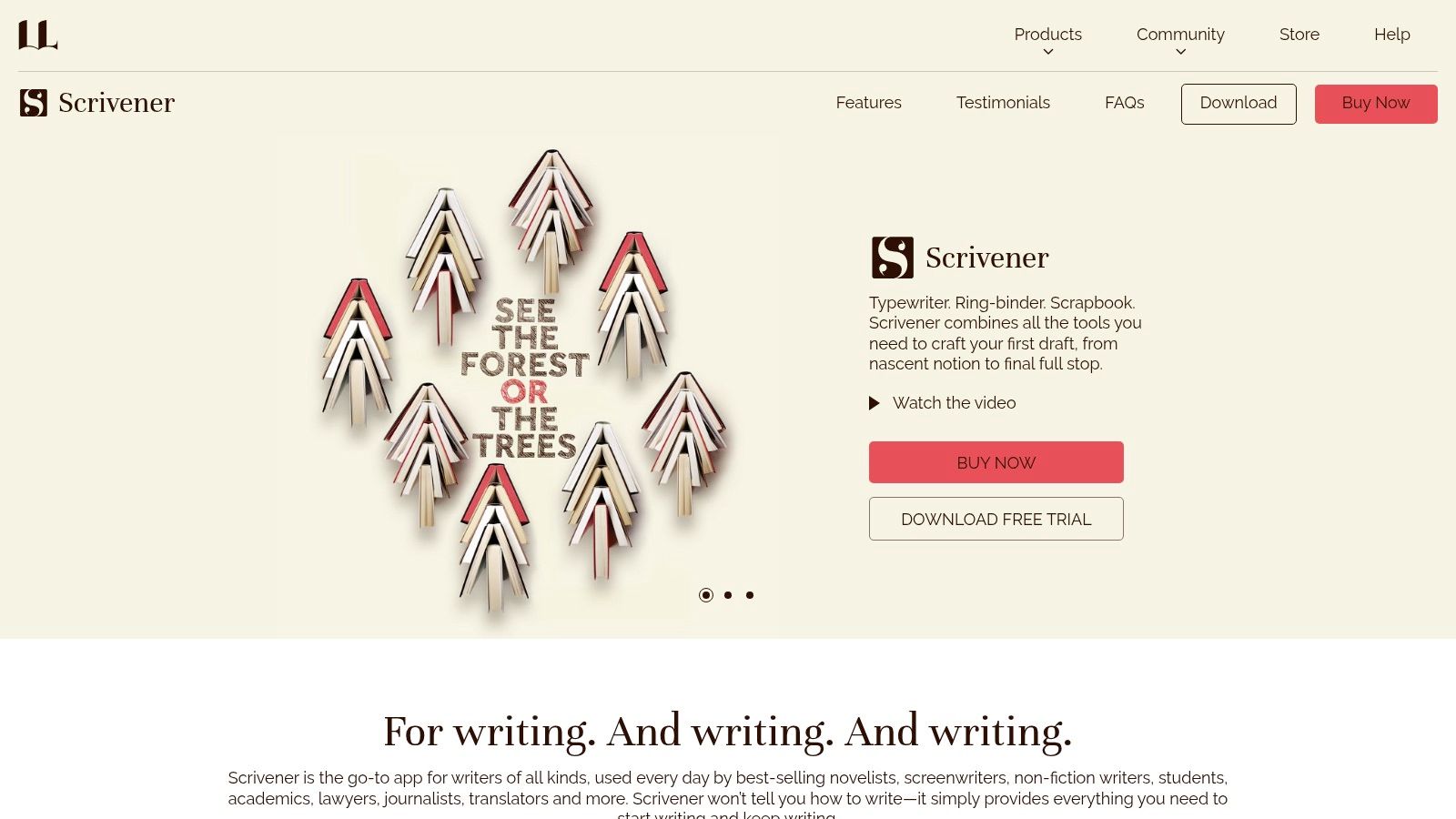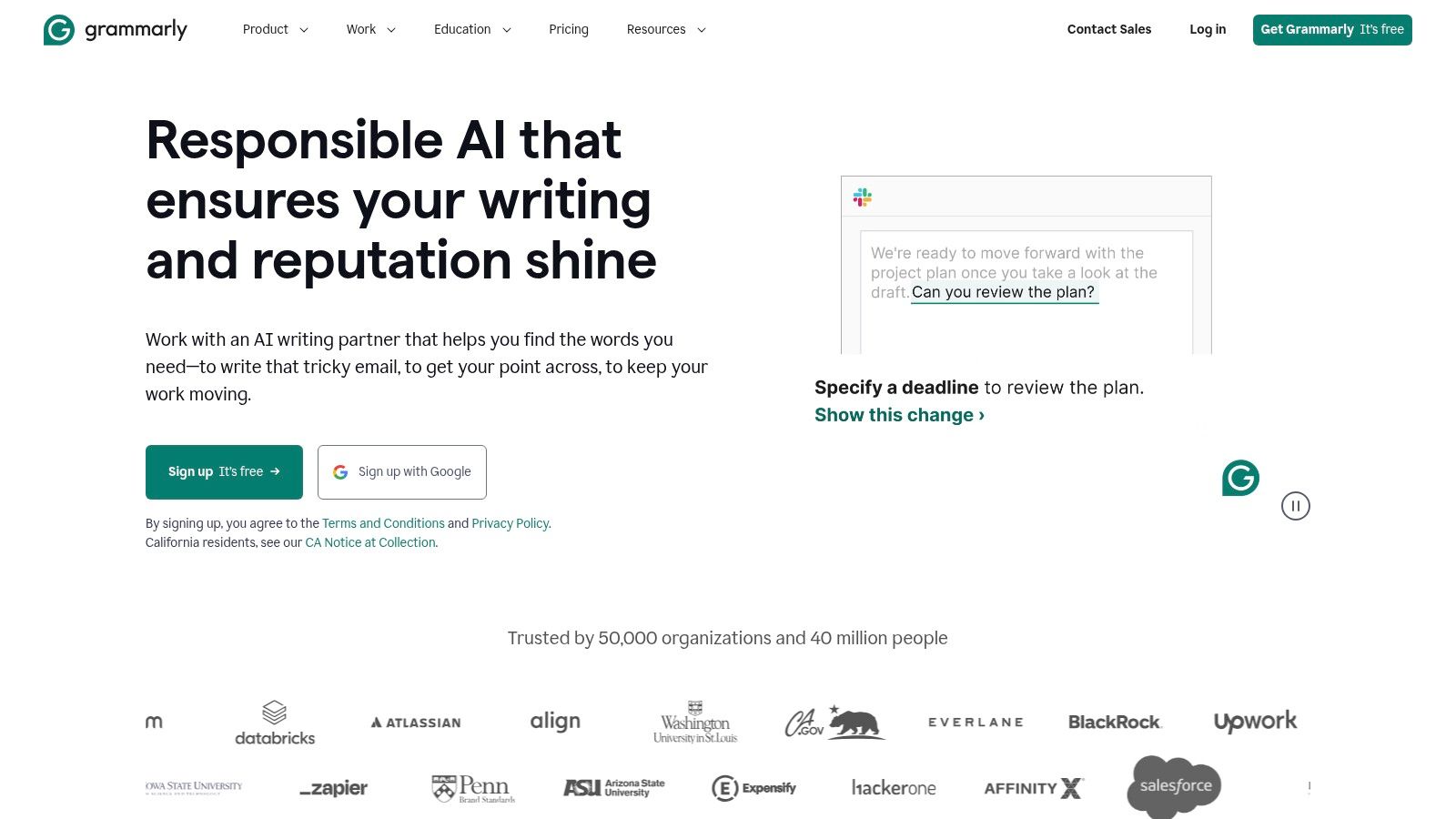Getting Started
Finding the best AI novel writing software can transform your creative process, helping you overcome writer's block, develop complex characters, and generate compelling plot points. These tools aren't here to replace your unique voice; they are sophisticated assistants designed to augment your storytelling capabilities. Whether you're a seasoned author looking to accelerate your drafting phase or a new writer struggling with the blank page, integrating AI can provide the structural support and creative spark needed to bring your story to life.
This guide provides a comprehensive breakdown of the leading platforms available. We'll move beyond marketing claims to offer a practical analysis of each tool's strengths and weaknesses. You will find detailed evaluations of key features, honest assessments of their limitations, and specific use-case scenarios to help you determine which software aligns with your personal writing style and project goals. We will cover everything from dedicated story-crafting platforms like Sudowrite to versatile assistants like Jasper AI and essential editing suites like ProWritingAid.
To truly unlock the potential of these platforms, your ability to guide the AI is paramount. Mastering how to write effective AI prompts is crucial for getting nuanced and high-quality results that match your vision. Let's dive into the options that can help you write your next novel more efficiently.
1. Sudowrite
Sudowrite stands out as arguably the best AI novel writing software for fiction authors focused on creative partnership rather than pure automation. It excels at being a brainstorming companion, helping writers overcome blocks and enrich their existing prose. Instead of just generating entire chapters, its strength lies in targeted, feature-rich tools that augment the author's own creativity.
For instance, the "Describe" feature is a game-changer for adding sensory depth. If you have a simple sentence like "The room was messy," you can highlight it and have Sudowrite generate evocative descriptions based on sight, sound, smell, and even metaphor. The "Brainstorm" tool offers a powerful way to generate character names, plot points, or world-building details with a simple prompt.
Key Features & Use Cases
- Write Button: This core function analyzes your current text and continues writing in your established style. It's ideal for pushing past a difficult scene or drafting a connecting paragraph when you feel stuck.
- Twists & Brainstorm: Perfect for the outlining phase or when your plot feels stale. Use it to generate unexpected plot twists or a list of potential character motivations.
- Feedback Tool: Get an instant critique on your writing, highlighting areas with clichés, pacing issues, or repetitive phrasing. This offers a useful first-pass revision before seeking human feedback.
Pros & Cons
- Pros: Its tools are specifically designed for creative fiction, making it more nuanced than general-purpose AI. The user interface is intuitive, encouraging experimentation.
- Cons: The AI's memory can struggle with maintaining perfect consistency across a long manuscript, requiring manual oversight. There's a learning curve to mastering all its features effectively.
Website: https://www.sudowrite.com/
2. Jasper AI
Jasper AI (formerly Jarvis) is a powerful and versatile AI writing assistant that, while not exclusively for fiction, has become a top contender for the best AI novel writing software due to its robust long-form content capabilities. Unlike tools built solely for creative prose, Jasper excels at generating coherent, structured text over thousands of words, making it ideal for authors who need help drafting entire scenes or chapters with consistent context.
Its strength lies in its command-based "Boss Mode," where you can direct the AI with specific instructions like "Write a paragraph about a detective finding a mysterious clue in a dusty library." This gives the author significant control over the narrative direction while still leveraging AI for the heavy lifting of drafting. You can also define a specific tone of voice, ensuring the output aligns with your characters and genre.

Key Features & Use Cases
- Long-Form Assistant: The core of Jasper for novelists. Use it to write extensive passages or full chapters. You can guide it with short prompts, and it will continue writing, maintaining the established plot and character voices.
- Recipes & Templates: Jasper offers pre-built workflows ("Recipes") for tasks like writing a story outline or a character bio. This is perfect for the planning stages, providing a structured way to build your novel's foundation.
- Content Improver & Re-phraser: If a paragraph feels weak or clunky, these tools can instantly rewrite it for clarity, improved tone, or greater impact, acting as an on-demand editor. You can learn more about Jasper's role as an AI writing assistant to see how it compares in different scenarios.
Pros & Cons
- Pros: Excellent at generating coherent and contextually aware long-form content. The customizable output styles and tones allow for greater creative control than many competitors.
- Cons: Has a steeper learning curve, especially for mastering "Boss Mode" commands. The pricing model can be more expensive than fiction-specific tools, particularly for access to its best features.
Website: https://www.jasper.ai/
3. NovelAI
NovelAI positions itself as an AI-assisted storytelling sandbox, prized for its high degree of customization and strong commitment to user privacy. It leverages its own fine-tuned language models, built upon GPT architecture, to provide a versatile and immersive writing experience. Where some tools focus on augmenting existing text, NovelAI excels at co-creating entire narrative worlds from the ground up, making it a powerful choice for authors who want a highly configurable creative partner.
It's particularly effective for genre fiction, offering specialized modules for fantasy, sci-fi, horror, and romance that understand the tropes and tones of those categories. The platform's emphasis on privacy, using encrypted servers for all user data, also provides peace of mind for writers working on sensitive or proprietary projects. Its integrated text-to-image synthesis further allows authors to visualize characters and settings as they write.

Key Features & Use Cases
- AI Modules & Customization: Train the AI on specific genres or even your own writing to ensure it generates text that aligns perfectly with your project's tone. This is ideal for maintaining a consistent voice in a long series.
- Lorebook: A powerful world-building tool that functions as a project-specific wiki. You can create entries for characters, locations, and magical systems, which the AI will reference to maintain plot consistency.
- Text-to-Image Generation: Bring your story to life visually by creating character portraits, environmental concept art, or illustrations for key scenes directly within the writing interface. If you're looking for more information, you can find further details about this AI story writer on textspell.com.
Pros & Cons
- Pros: Exceptional customization allows for a highly personalized AI assistant. The strong privacy policy is a major advantage. Its focus on immersive, long-form storytelling is great for novelists.
- Cons: The user interface can feel less intuitive and more technical than some competitors, requiring an initial learning period. Some of the most powerful features, like advanced AI models, are locked behind higher-tier subscriptions.
Website: https://novelai.net/
4. Squibler
Squibler is a comprehensive writing platform that integrates AI to support authors from the initial idea to the final manuscript. It positions itself as an all-in-one organizational tool, making it one of the best AI novel writing software options for writers who value structure and project management. Rather than just offering a text generator, Squibler provides a robust framework for outlining, character development, and scene construction, helping to keep complex narratives on track.
The platform's strength lies in its combination of a traditional writing editor with smart AI assistance. For example, its book management interface allows you to break your novel into chapters and scenes, which can be easily rearranged. You can then use the AI Smart Writer within each scene to generate content, expand on ideas, or overcome writer's block, ensuring each part aligns with your broader structural plan.

Key Features & Use Cases
- AI Smart Writer: This feature is perfect for generating scene descriptions, dialogue, or plot progressions. Use it when you have a clear outline but need help fleshing out the specific details of a scene.
- Plot Structure Templates: Ideal for beginners or those trying a new genre. Squibler offers pre-built templates like the Hero's Journey or Save the Cat, providing a scaffold for your story.
- Chapter & Scene Organization: Use this to maintain a high-level overview of your novel. It's incredibly useful for tracking subplots and ensuring your pacing is correct across the entire manuscript.
Pros & Cons
- Pros: The emphasis on organization and structure is a major benefit for managing long-form projects. Its user-friendly interface simplifies the writing process, and the export options are versatile.
- Cons: The AI features, while helpful, can feel less creatively nuanced than specialized tools like Sudowrite. The free trial is limited, requiring a subscription for full access.
Website: https://www.squibler.io/
5. Writesonic
Writesonic positions itself as a versatile AI content creation suite, but its powerful long-form editor and story-generation tools make it a solid contender for the best AI novel writing software, especially for authors who need more than just creative prose assistance. While not exclusively for fiction, its robust engine, built on advanced models like GPT-4, can produce detailed narrative arcs, character backstories, and even entire chapters from simple prompts.
This tool shines for writers who value structured, template-driven creation. Instead of a freeform creative partner, Writesonic provides over 100 templates, including specific ones for story outlines and generation. This approach is beneficial for authors who need to quickly build a framework for their novel or generate supplementary content, such as marketing copy or blog posts about their book, all within one platform.

Key Features & Use Cases
- AI Article & Blog Writer: While named for articles, this feature is excellent for drafting entire novel chapters. You can input a detailed outline or a scene summary, and it will generate a long-form narrative piece you can then refine.
- Story Generator: A dedicated tool for creating short stories or scene ideas from a basic prompt. It's useful for generating initial concepts or exploring side plots without committing significant time.
- Content Rephraser & Expander: Perfect for revision. Use the rephraser to find new ways to word a clunky sentence or the expander to flesh out a brief paragraph with more descriptive detail.
Pros & Cons
- Pros: The use of advanced AI models like GPT-4 ensures high-quality, coherent output. Its extensive template library and multilingual support (24+ languages) make it highly versatile.
- Cons: The sheer number of features can present a learning curve for new users. A heavy reliance on templates might feel restrictive for writers who prefer a more organic, free-flowing creative process.
Website: https://writesonic.com/
6. Rytr
Rytr positions itself as a highly accessible and versatile AI writing assistant, making it a strong contender for authors who need more than just a novel-writing tool. While not exclusively designed for long-form fiction like some competitors, its strength lies in its speed, simplicity, and a wide array of content templates that can be adapted for the novel-writing process. It excels at generating short-form content that can be pieced together, such as character backstories, dialogue snippets, or setting descriptions.

The platform's "Story Plot" use case is a fantastic starting point for outlining, providing a structured narrative arc from a simple idea. For authors who also manage a blog or social media presence to promote their work, Rytr becomes an invaluable all-in-one tool, capable of drafting a chapter summary one moment and a promotional tweet the next.
Key Features & Use Cases
- Story Plot Generator: A dedicated template for creating basic plot structures. This is ideal for brainstorming initial concepts or developing subplots for existing characters.
- Multiple Tones & Languages: Select from over 20 tones (e.g., "enthusiastic," "convincing," "formal") to guide the AI's output, which is useful for maintaining a consistent voice in dialogue or narration.
- Reword & Improve: Highlight any text to have the AI rephrase it for clarity, or improve the sentence structure. This is perfect for a quick first-pass edit to polish rough prose.
Pros & Cons
- Pros: Its extremely generous free plan and affordable paid tiers make it one of the most cost-effective options. The user-friendly interface is simple to learn and navigate.
- Cons: Less specialized for long-form novel writing, lacking the deep narrative continuity and memory of dedicated tools. It often requires significant manual editing to connect generated snippets into a cohesive chapter.
Website: https://rytr.me/
7. Scrivener
Scrivener is a legendary word processor and project management tool beloved by novelists for its organizational power. While not a native AI-first platform like others on this list, its structure makes it an exceptional partner for AI-generated content. Instead of AI features being built-in, Scrivener serves as the ultimate workbench where you can organize, compile, and refine text generated from other AI tools, making it a cornerstone for many writers using the best AI novel writing software as part of a larger ecosystem.

The software's strength lies in its non-linear approach. You can write scenes out of order, store research notes alongside your manuscript, and visualize your entire novel on a virtual corkboard. For AI-assisted writers, this means you can drop generated character sketches, plot ideas, or scene snippets into their respective folders within Scrivener, maintaining perfect organization as your project grows.
Key Features & Use Cases
- Corkboard & Outliner: Use these views to map out your entire plot structure. You can paste AI-generated plot points onto virtual index cards and easily rearrange them to test different narrative flows before writing a single word of prose.
- The Binder: This sidebar is the organizational heart of Scrivener. Create separate documents for each chapter, scene, character profile, or research item. It's perfect for isolating sections to feed into an external AI for expansion or revision.
- Compile for Export: Once your draft is complete, Scrivener's powerful compile feature can export your manuscript into various formats (e.g., .epub, .mobi, .docx) for agents, publishers, or self-publishing platforms.
Pros & Cons
- Pros: Unmatched organizational capabilities for complex novels. Its one-time purchase model is cost-effective in the long run. The distraction-free mode helps with focused writing sprints.
- Cons: Has a notoriously steep learning curve compared to simpler apps. It lacks native AI integration, requiring you to use it in tandem with other tools, which can disrupt workflow.
Website: https://www.literatureandlatte.com/scrivener/overview
8. Grammarly
While not a story generator, Grammarly serves an essential, complementary role, making it one of the best AI novel writing software tools for the crucial editing phase. It functions as an intelligent proofreader, moving far beyond basic spell-checking to offer sophisticated feedback on grammar, punctuation, style, and tone. For novelists, this means catching subtle errors that slip through manual edits, ensuring the final manuscript is polished and professional.

Its strength lies in its real-time suggestions and platform integration. As you write in Word, Scrivener, or a browser, Grammarly provides instant feedback, allowing you to fix mistakes on the fly. The premium version's Tone Detector is particularly useful for fiction, helping ensure your dialogue or narration consistently conveys the intended emotion, from formal to assertive. A detailed overview of Grammarly's capabilities as a grammar checker can provide further insight into its features.
Key Features & Use Cases
- Real-time Corrections: Instantly identifies and suggests fixes for grammatical errors, spelling mistakes, and punctuation issues as you type, streamlining the first-pass editing process.
- Tone & Clarity Suggestions: Analyzes word choice and phrasing to help you adjust your writing's tone. It can rewrite clunky sentences for better readability, which is invaluable for clarifying complex narrative passages.
- Genre-specific Styles: You can set goals for your document based on audience and genre (e.g., "Creative"), and Grammarly will tailor its suggestions accordingly, though this is less nuanced than a dedicated fiction editor.
Pros & Cons
- Pros: Significantly improves the technical quality of prose with minimal effort. The browser and desktop integrations make it incredibly easy to use across different writing platforms.
- Cons: The free version is quite limited. Its AI can sometimes misinterpret the artistic intent behind unconventional sentence structures common in creative fiction, leading to unhelpful suggestions.
Website: https://www.grammarly.com/
9. ProWritingAid
While many tools focus on AI content generation, ProWritingAid carves its niche as one of the best AI novel writing software options for the crucial editing phase. It functions less like a creative partner and more like a meticulous line editor, using AI to provide deep, analytical feedback that goes far beyond standard grammar checks. Its strength is in polishing a completed draft to a professional standard.

For authors, ProWritingAid's manuscript-level reports are indispensable. It can analyze your entire book for pacing issues, flagging chapters that might drag. It also checks for emotional tells, dialogue tag variety, and crutch words you might not notice yourself. This makes it an essential tool for self-editing before sending a manuscript to a human editor, saving both time and money.
Key Features & Use Cases
- In-depth Reports: Generate over 20 unique reports on your text, covering everything from sentence length variation and readability to sticky sentences and pacing. This is ideal for a final, comprehensive self-edit.
- Style and Grammar Engine: Provides real-time suggestions to improve style, eliminate clichés, correct grammar, and enhance word choice directly within your writing environment.
- Consistency Checks: The AI automatically scans your manuscript to ensure names, capitalization, and even hyphenation are used consistently from start to finish.
- Integrations: Works seamlessly with Scrivener, Google Docs, and Microsoft Word, allowing you to edit where you write without disruptive copy-pasting.
Pros & Cons
- Pros: The sheer depth of its analytical reports is unparalleled, offering insights you won't get from simpler editors. Excellent integration support makes it easy to adopt into any workflow.
- Cons: It's primarily an editor, not a generator, so it won't help with writer's block. The free version is quite limited, and the sheer number of reports can feel overwhelming initially.
Website: https://prowritingaid.com/
10. ChatGPT Plus
While not a dedicated novel-writing application, ChatGPT Plus offers a powerful and versatile AI engine that can be an indispensable tool for authors. As the premium version of OpenAI's model, it provides faster responses and access to the latest features, making it a robust assistant for nearly any writing task. Its strength lies in its conversational flexibility, allowing writers to use it as a brainstorming partner, a dialogue coach, or an on-demand world-building consultant.
Unlike specialized software, ChatGPT's utility is defined by the user's creativity in crafting prompts. An author can ask it to generate ten potential plot hooks for a mystery novel, develop a character's backstory based on a few key traits, or even suggest realistic dialogue for a specific historical period. This makes it one of the most adaptable options on the list for authors who are comfortable with prompt engineering.

Key Features & Use Cases
- Context-Aware Brainstorming: Feed it your story's premise and ask for character ideas, setting details, or thematic suggestions. Its ability to maintain context in a single conversation is perfect for iterative development.
- Realistic Dialogue Generation: Provide the context of a scene and the personalities of the characters involved. Ask it to write dialogue, specifying the tone, subtext, or desired outcome of the conversation.
- Outlining and Structuring: Use it to break down a complex plot into a three-act structure, outline individual chapters, or create a beat sheet for a specific scene you're struggling to pace.
Pros & Cons
- Pros: Extremely versatile for all stages of writing, from initial idea to polishing prose. The user-friendly interface is simple to use, and it benefits from constant updates by OpenAI.
- Cons: Requires skillful prompt engineering to get high-quality, specific results. Its memory can be limited for maintaining perfect consistency across an entire novel-length project without re-feeding context.
Website: https://chat.openai.com/
11. Atticus
Atticus positions itself less as a pure AI writing assistant and more as an all-in-one writing and professional formatting platform. It's built for authors who want a single application to take their manuscript from the first draft to a publish-ready file for both ebook and print formats. While it's not a contender for the best AI novel writing software based on generative capabilities, its inclusion is for authors who need robust organizational and production tools in one place.

The primary strength of Atticus lies in its formatting engine. It provides a live preview that shows you exactly how your book will look as a print book or on an e-reader as you make changes. This removes the guesswork often associated with formatting tools like Vellum (which is Mac-only) or the complex process of using Word and Calibre.
Key Features & Use Cases
- Pro Writing & Formatting: The core feature is its dual-purpose interface. You can write in a clean, distraction-free environment and then switch to a powerful formatting tool with pre-built professional templates.
- Goal Setting & Tracking: Set daily writing goals or a project deadline, and Atticus will help you track your progress to stay on schedule. This is perfect for NaNoWriMo or any deadline-driven project.
- Cross-Platform Availability: Unlike many competitors, Atticus works on Windows, Mac, Linux, and Chromebooks, making it highly accessible.
Pros & Cons
- Pros: The one-time payment for lifetime access offers excellent value. Its ability to handle both writing and complex formatting in one app streamlines the book production process.
- Cons: Its AI features are virtually non-existent compared to dedicated tools like Sudowrite or Jasper. The learning curve is focused on mastering formatting options rather than AI prompting.
Website: https://atticus.io/
12. Character.AI
Character.AI takes a unique approach to novel writing by focusing entirely on one of the most crucial elements: the characters themselves. Rather than generating prose, it allows authors to create and interact with their characters through a conversational chat interface. This makes it an exceptional tool for developing authentic dialogue, exploring character motivations, and testing how a character would react in specific scenarios before ever writing them into a scene.

The platform functions like a digital improvisation partner. You can define your character's core traits, backstory, and personality, and then "interview" them. Ask them about their fears, their first love, or their opinion on another character in your story. This interactive process helps solidify voice and personality, making it a powerful component in an author's toolkit, even if it isn't an all-in-one AI novel writing software.
Key Features & Use Cases
- Interactive Character Chat: The primary function. "Talk" to your characters to test their voice, explore their psyche, or workshop difficult dialogue sections.
- Character Creation Suite: Define a character from scratch by inputting their name, greeting, and detailed personality attributes to guide the AI's responses.
- Community Characters: You can interact with thousands of characters created by other users, including historical figures and famous fictional personalities, which can serve as inspiration.
Pros & Cons
- Pros: Unmatched for developing deep, consistent character voices. The interactive format is highly engaging and excellent for overcoming writer's block related to character motivation. It is currently free to use.
- Cons: Its scope is limited strictly to character interaction, not plot generation or prose writing. The free model may eventually transition to a paid subscription.
Website: https://beta.character.ai/
Top 12 AI Novel Writing Tools Comparison
| Tool | Core Features ✨ | User Experience ★★★★☆ | Value Proposition 💰 | Target Audience 👥 | Unique Selling Points 🏆 |
|---|---|---|---|---|---|
| Sudowrite | Creative storytelling tools, Google Docs integration | User-friendly, some learning curve | Moderate cost | Fiction authors, novelists | "Describe" sensory detail, Twist & Brainstorm tools ✨ |
| Jasper AI | 50+ templates, long-form content, plagiarism checker | Customizable, requires learning | Higher cost | Broad writers, marketers | Multi-language, versatile long-form writing 🏆 |
| NovelAI | AI plot & character dev, encrypted servers, text-to-image | Less intuitive interface | Subscription tiers | Privacy-conscious storytellers | Strong privacy, text-to-image synthesis ✨ |
| Squibler | Scene gen, book manager, plot templates | User-friendly, some learning curve | Limited free trial | Novel writers, genre diverse | Book management & plot structure tools 🏆 |
| Writesonic | 100+ templates, plagiarism, multi-language | High-quality AI, extensive templates | Mid-range pricing | Content creators, marketers | Large template library, multi-language support 🏆 |
| Rytr | Multiple tones, grammar & plagiarism check | Easy, cost-effective | Affordable plans | Casual & professional writers | Affordable with rewording tool ✨ |
| Scrivener | Outlining, AI plot, multi-format export | Steep learning curve | One-time purchase | Professional novelists & authors | Advanced organizing, distraction-free mode 🏆 |
| Grammarly | Real-time grammar, tone, plagiarism | User-friendly | Freemium | General writers | Real-time style and clarity feedback 🏆 |
| ProWritingAid | In-depth style reports, consistency checks | User-friendly, feature-rich | Subscription | Editors, serious writers | Detailed manuscript analysis 🏆 |
| ChatGPT Plus | Context-aware storytelling, multi-style | User-friendly, prompt tuning needed | Subscription | Versatile writers | Realistic dialogue, versatile tasks 🏆 |
| Atticus | Distraction-free, formatting & export options | User-friendly | One-time fee | Self-publishers, authors | Professional formatting & cross-platform 🏆 |
| Character.AI | Character creation, interactive chat | User-friendly | Free beta | Writers focusing on characters | Dynamic character interaction ✨ |
Final Thoughts
Navigating the landscape of AI-powered writing tools can feel as complex as plotting a multi-generational epic. As we've explored, the "best AI novel writing software" isn't a single, definitive answer but a personalized choice that hinges on your specific needs, creative process, and technical comfort level. The true power of these platforms isn't to replace your unique voice but to augment it, acting as a tireless brainstorming partner, a meticulous editor, or a creative co-pilot to help you overcome writer's block and bring your story to life more efficiently.
Key Takeaways and Selecting Your AI Partner
Our deep dive into tools ranging from the creatively focused Sudowrite and NovelAI to the structured environment of Scrivener combined with AI assistants reveals a clear spectrum. Some platforms excel at pure prose generation, while others specialize in organization, editing, or character development.
To make the right choice, consider these core factors:
- For Plotters and World-Builders: If you thrive on detailed outlines, character sheets, and intricate world-building, a tool like Squibler or the combination of Scrivener with ChatGPT Plus provides the structural backbone you need. These setups allow you to manage complexity while leveraging AI for targeted content generation within that framework.
- For "Pantsers" and Exploratory Writers: If you discover your story as you write, the fluid, inspiring nature of Sudowrite is unparalleled. Its "Write" and "Describe" features act as creative prompts, helping you expand on a single sentence and discover narrative threads you hadn't anticipated. NovelAI offers a similar, highly customizable experience for those who want to fine-tune the AI's creative style.
- For Polishing and Perfection: For writers whose primary need is refining a completed or partial draft, the powerful editing suites of ProWritingAid and Grammarly are indispensable. They go far beyond simple spell-checking, offering insights into pacing, style, and readability that are crucial for a professional-grade manuscript.
- For Budget-Conscious Writers: Tools like Rytr offer a generous free tier, providing a fantastic entry point to understand how AI can assist with brainstorming, character sketches, and overcoming minor hurdles without a significant financial commitment.
Implementing AI into Your Writing Workflow
Successfully integrating any of these tools requires a shift in mindset. Don't view them as ghostwriters but as specialized assistants. Start small. Use an AI to generate five different descriptions of a fantasy city, then choose the elements you like and rewrite them in your own voice. Feed it a dialogue snippet and ask it to propose three different emotional reactions from a character. This iterative process ensures the final product remains authentically yours. The goal is collaboration, not automation. By using AI to handle the heavy lifting of initial drafting or to break through creative slumps, you free up more mental energy for the high-level work: crafting compelling characters, weaving intricate plots, and finessing the prose that only you can write.
Ultimately, the journey to finding the best AI novel writing software is a personal one. Experiment with free trials, test different platforms with the same scene, and see which one clicks with your creative rhythm. The perfect tool is out there, ready to help you turn that lingering idea into a finished novel.
Ready to enhance your writing process even further? While the tools above focus on long-form creation, ensuring your author platform and marketing materials are flawless is just as important. TextSpell offers a powerful, AI-driven suite for crafting compelling social media posts, author bios, and book descriptions that capture attention. Elevate your entire author brand by visiting TextSpell and see how it can perfect your professional presence.

